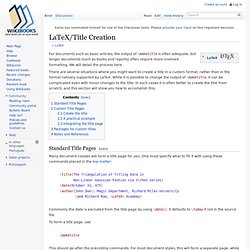

Online LaTeX Equation Editor - create, integrate and download. LaTeX Cookbook. Mathematics part 1 - Getting to grips with LaTeX. By Andrew Roberts One of the greatest motivating forces for Donald Knuth when he began developing the original TeX system was to create something that allowed simple construction of mathematical formulae, whilst looking professional when printed.

The fact that he succeeded was most probably why Tex (and later on, LaTeX) became so popular within the scientific community. Regardless of the history, typesetting mathematics is one of LaTeX's greatest strengths. However, it is also a large topic due to the existence of so much mathematical notation. So, this will be part one - getting to know the basics. Maths environments LaTeX needs to know beforehand that the subsequent text does in fact contain mathematical elements. Text - text formulae are displayed inline, that is, within the body of text were it is declared. e.g., I can say that a + a = 2a within this sentence. displayed - displayed formulae are separate from the main text.
Symbols Mathematics has lots and lots of symbols! Fractions Roots. Fonts, Scope, and Symbols. (URL: Since LaTeX is a formatter, all changes in the format of text must be expicitly expressed.

In addition, some characters that you may want to use in text have been reserved for use by LaTeX, so they have to be input as special characters. These formatting details in LaTeX are accomplished by control sequences. To change the font type or font size in a LaTeX document, you use one of the following control sequences. \it - italics typeface \sl - slanted typeface \bf - boldface typeface \sf - san serif typeface \tt - typewriter typeface \rm - normal (roman) typeface. LaTeX help 1.1 - License. Go to the first, previous, next, last section, table of contents.

The programs currently being distributed that relate to Texinfo include two portions of GNU Emacs, plus two other separate programs (texindex and texinfo.tex). These programs are free; this means that everyone is free to use them and free to redistribute them on a free basis. The Texinfo related programs are not in the public domain; they are copyrighted and there are restrictions on their distribution, but these restrictions are designed to permit everything that a good cooperating citizen would want to do. What is not allowed is to try to prevent others from further sharing any version of these programs that they might get from you. To make sure that everyone has such rights, we have to forbid you to deprive anyone else of these rights.
Also, for our own protection, we must make certain that everyone finds out that there is no warranty for the programs that relate to Texinfo. Getting Started with LaTeX. LaTeX/Title Creation. For documents such as basic articles, the output of \maketitle is often adequate, but longer documents (such as books and reports) often require more involved formatting.

We will detail the process here. There are several situations where you might want to create a title in a custom format, rather than in the format natively supported by LaTeX. While it is possible to change the output of \maketitle, it can be complicated even with minor changes to the title. In such cases it is often better to create the title from scratch, and this section will show you how to accomplish this. Standard Title Pages[edit] Many document classes will form a title page for you. Commonly the date is excluded from the title page by using \date{}. To form a title page, use This should go after the preceding commands. Footnotes within the title page can be specified with the \thanks command. The \thanks command can also be used in the \title. Custom Title Pages[edit] LaTeX. This is a guide to the LaTeX markup language.

It is intended to form a useful resource for everybody from new users who wish to learn, to old hands who need a quick reference. TeX and LaTeX TeX is a computer program for typesetting documents, created by Donald Knuth. It takes a suitably prepared computer file and converts it to a form which may be printed on many kinds of printers, including dot-matrix printers, laser printers and high-resolution typesetting machines. LaTeX is a set of macros for TeX that aims at reducing the user's task to the sole role of writing the content, LaTeX taking care of all the formatting process. The book is organized in different parts. Getting Started will provide you with the very first steps to print your first document: general concepts (very important!) Contents[edit] If you have questions related to LaTeX, ask at the Q&A. Edit the TOC or the stages Other wikibooks[edit]